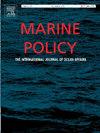Moving towards sustainable whale shark-human interactions: A case study in Bahía de La Paz, Baja California Sur, Mexico
IF 3.5
2区 社会学
Q2 ENVIRONMENTAL STUDIES
引用次数: 0
Abstract
Whale shark tourism has experienced a significant increase in demand in recent decades, which may stress these animals or alter their behavior. Therefore, assessing the tourism carrying capacity (TCC) for whale-shark interactions is crucial for sustainable management. Despite Bahía de La Paz being established as a whale shark refuge in 2018 and improvements in management strategies for human-whale shark interactions due to increased oversight of tourism providers, 50–60 % of whale sharks are still injured yearly. This research assesses the TCC for swim-with-whale shark activities at the aggregation site in Bahía de La Paz to incorporate it into a decision-support system for tourism management. We developed the numerical formulation of the TCC following the precautionary principle based on the management factors necessary to estimate a carrying capacity that aligns with current whale shark regulations in Mexico, derived from monitoring data collected between 2005 and 2022. We compared the TCC assessments conducted for two scenarios: a low-regulated period (2015–2016 season) and a high-regulated period (2018–2022 season). The effective carrying capacity (ECC) post-regulation allows more tourism boats per turn compared to the pre-regulation period, primarily due to increased observed whale sharks. In addition, we present a dynamic TCC assessment that adjusts the number of tourist boats based on the observed whale shark population in the area. We hope the government implements this model into the management plan of the species to reduce pressure on whale sharks and lessen the impact on the species.
求助全文
约1分钟内获得全文
求助全文
来源期刊

Marine Policy
Multiple-
CiteScore
7.60
自引率
13.20%
发文量
428
期刊介绍:
Marine Policy is the leading journal of ocean policy studies. It offers researchers, analysts and policy makers a unique combination of analyses in the principal social science disciplines relevant to the formulation of marine policy. Major articles are contributed by specialists in marine affairs, including marine economists and marine resource managers, political scientists, marine scientists, international lawyers, geographers and anthropologists. Drawing on their expertise and research, the journal covers: international, regional and national marine policies; institutional arrangements for the management and regulation of marine activities, including fisheries and shipping; conflict resolution; marine pollution and environment; conservation and use of marine resources. Regular features of Marine Policy include research reports, conference reports and reports on current developments to keep readers up-to-date with the latest developments and research in ocean affairs.
 求助内容:
求助内容: 应助结果提醒方式:
应助结果提醒方式:


